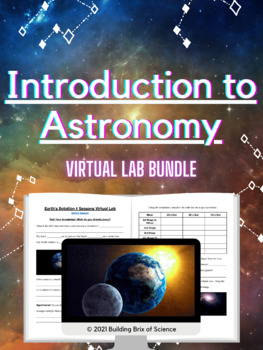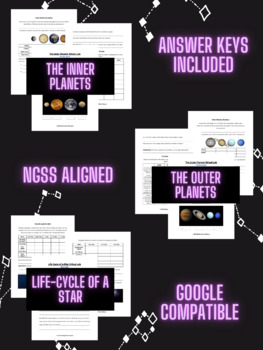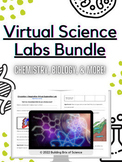Introduction to Astronomy Virtual Lab Bundle
- Zip
- Internet Activities
Products in this Bundle (6)
showing 1-5 of 6 products
Also included in
- Save 30% on my store's entire virtual lab collection with this Science Virtual Exploration Labs Activity Bundle! These Virtual Labs cover a wide range of topics, including Chemistry, Astronomy, Genetics, and more! If you would like to try a free sample, please download Into the Bloodstream from my sPrice $157.50Original Price $225.00Save $67.50
- Get over 30% off each assignment with the Introduction to Earth Science Virtual Lab Bundle! These Virtual Labs cover a wide range of topics, including Earth's Systems, Stars, & the Solar System! Included in this Virtual Lab Bundle are:AstronomyThe Inner PlanetsThe Outer PlanetsLife Cycle of a StPrice $35.50Original Price $51.00Save $15.50
Description
Get 30% off each lab with the Introduction to Astronomy Virtual Lab Bundle! These six interactive lab assignments will help your students explore the Planets & Stars of our Solar System and the Earth-Sun-Moon system. Students will learn:
The Inner Planets
⚗️Test their Pre-Existing Knowledge of the Solar System
⚗️Identify the Inner Planets based on Size & Appearance
⚗️Record Data such as Number of Moons, Orbit Period, & Surface Characteristics
⚗️Analyze the Mantle, Crust, & Core Compositions of the Inner Planets
The Outer Planets
⚗️Test their Pre-Existing Knowledge of the Solar System
⚗️Identify the Outer Planets based on Size & Unique Features
⚗️Record Data such as Number of Moons, Orbit Period, & Surface Characteristics
⚗️Analyze the Atmospheric, Mantle, & Core Compositions of the Outer Planets
Life-Cycle of a Star
⚗️Test their Pre-Existing Knowledge of Stars
⚗️Analyze the Fusion of Hydrogen Atoms into Helium
⚗️Explain the Correlation between a Star's Mass and its' Age
⚗️Investigate the Formation of Neutron Stars & Black Holes
Earth's Rotation & Seasons
⚗️Test their Pre-Existing Knowledge of Rotation vs. Revolution
⚗️Describe how the Earth's Rotation results in Day & Night
⚗️Analyze how different Seasons occur in different Hemispheres simultaneously
⚗️Create Visual Models of the Earth's Tilt at different Latitudes
Lunar Phases
⚗️Test their Pre-Existing Knowledge of the Moon
⚗️Describe how the Moon's Rotation & Revolution keep it facing the Earth
⚗️Identify & Draw the Lunar Phases in the Correct Order
⚗️Analyze how Two People on Earth can see the same Lunar Phase
Solar & Lunar Eclipses
⚗️Test their Pre-Existing Knowledge of an Eclipse
⚗️Identify the Lunar Phases that occur during Eclipses
⚗️Draw Diagrams of a Solar & Lunar Eclipse
⚗️Compare & Contrast Partial and Total Eclipses
NOTE: These activities link to the free Interactives below. Check them out!
Purchase includes Six Full Assignments, each with a 3-page Student Worksheet (PDF), a 3-page Teacher Answer Key (PDF) and 3-page Digital Student Worksheet for each lab (Google).
VIRTUAL LEARNING
These labs come with a Google Slides version of the Student Worksheet hyperlinked in the Teacher Answer Keys - these labs are designed for digital and face-to-face learning!
❗Permission is granted to copy pages specifically for student or teacher use only by the original purchaser or licensee. The reproduction of this product for any other use is strictly prohibited. Copying this product in any part and placing it on the Internet (even on a personal website) is strictly prohibited and a violation of the Digital Millennium Copyright Act (DCMA).
________________________________________________________________
⭐ BE THE FIRST TO LEARN ABOUT NEW SCIENCE RESOURCES! ⭐
Hit the Green Star at the top of the page to follow my store! This will allow you to receive notifications whenever I update current resources and add brand new items.






